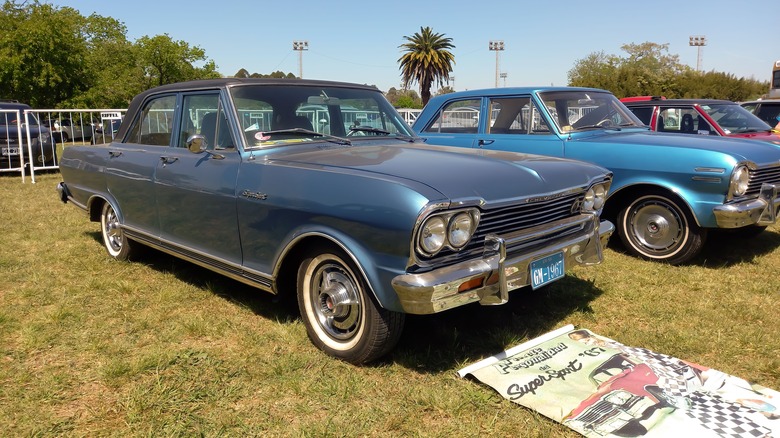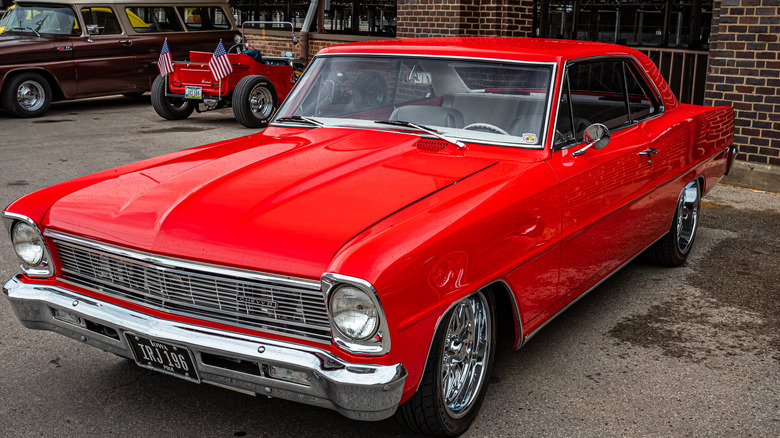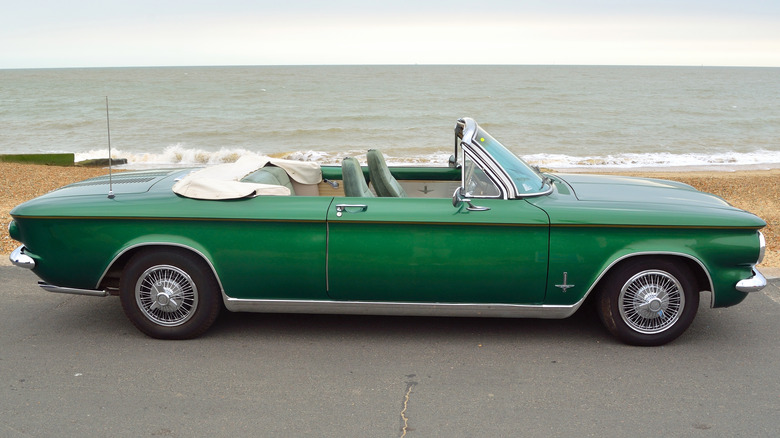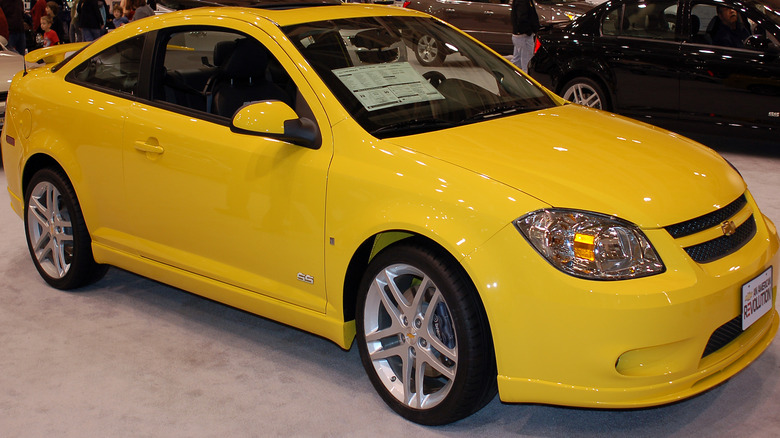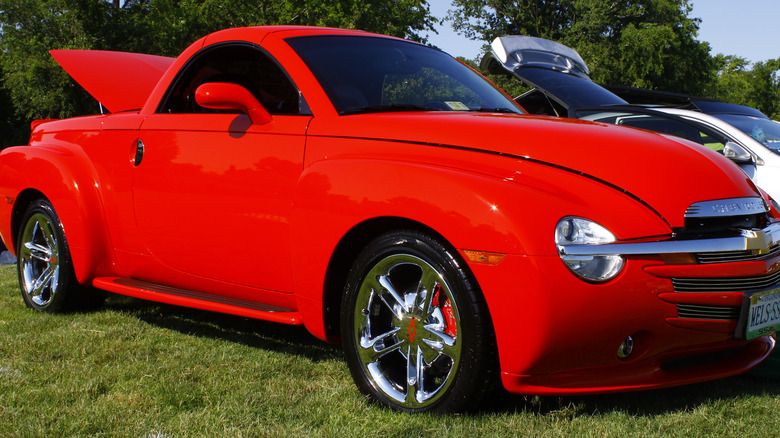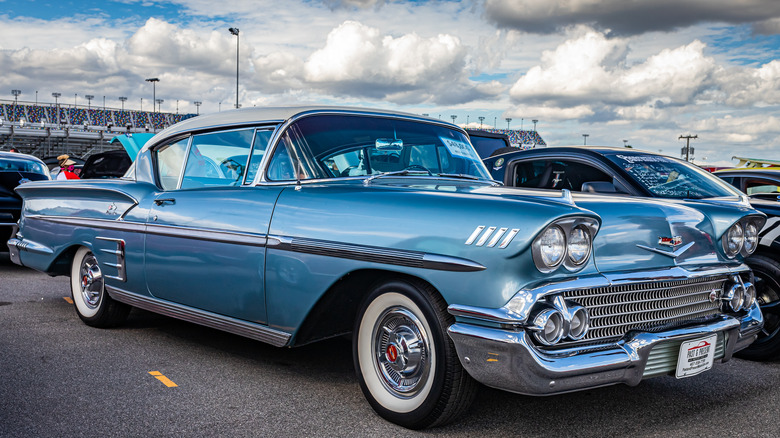5 Cars Chevrolet Should Have Never Discontinued
Chevrolet is one of the oldest, most well-known American auto manufacturers, so it's no surprise that the list of cars it has produced is as long as it is varied. There's been Chevy trucks, Chevy sedans, Chevy sports cars, and everything in between. While some are more famous — like the Corvette, which recently celebrated its 70th anniversary – others are interesting footnotes in the company's history.
Many admirers of the manufacturer would love to see some of their favorite discontinued models come back, whether for aesthetic or nostalgic reasons or because they were well-made and pulled from the market before their time. But some beloved lines, like the full-bodied Monte Carlo and Caprice, may not make sense in the modern day, when traffic and gas prices punish large, wide cars. And while Chevy's trucks have their fair share of admirers, it was never the company's forte. But there are several models that are not only missed, but would still fit right in today and have something to offer current drivers. Here are some of the cars Chevrolet should have never discontinued.
Nova
Younger drivers may not remember or have a nostalgic affinity for the Chevy Nova, but many older drivers fondly remember the Chevrolet muscle car that was in production for most of the '60s and '70s, as well as in the mid-'80s. Notable models include the 1963 Nova SS, which was the only convertible from the line, and the 1968 Nova SS, which was a small — but powerful — muscle car that had a 350 V8 engine at its heart.
It would be very exciting for Chevrolet enthusiasts to see what the company could do with a next-generation version of the Nova, preserving the spirit of the car while souping it up with state-of-the-art engineering that has been developed in the 35 years since the Nova was in production. Considering it already has a futuristic-sounding name (ironically, an urban legend says that the model sold poorly in Spanish-speaking countries because the name translates to "does not go"), the Nova would be the perfect moniker for a new, electric muscle car from Chevy.
Corvair
Chevrolet looked to tap into the growing appetite for cheaper, compact cars in the 1960s with its Corvair and kept it in production for the entirety of the decade. Despite being a smaller, more economical vehicle, the Corvair still packed some punch under its hood. In fact, the rear-mounted, air-cooled design of its engine was so unique that the Corvair still remains the only American-made, mass-produced vehicle to utilize it. It also had an air of class and excitement to it, with its name coming from the words "Corvette" and "Bel Air" being mashed together.
The Corvair was also versatile and was originally offered in several forms: as a four-door sedan, pickup truck, van, convertible, two-door convertible, and station wagon. Its station wagon design was somewhat prescient in that it evoked the tastes of modern drivers who have been generally eschewing traditional sedans. That makes the Corvair a perfect car for Chevrolet to bring back to the contemporary market, which has been favoring compact and inexpensive vehicles in an age where gas prices are soaring and street parking is increasingly harder to find.
Cobalt
The Chevy Cobalt was one of the more recent models to come from Chevrolet, debuting in 2004 as a successor to the Cavalier. It was produced until 2010 (when it was replaced by the Cruze), but the name lived on in a South American sedan from General Motors until 2019. It was a relatively unremarkable car and had a design meant to blend into the background as opposed to catching your attention, but the Cobalt is still fresh in the memories of a lot of drivers. Plus, with plenty of pre-owned cars still populating the streets, it wouldn't be that big of a stretch for Chevrolet to bring the Cobalt out of retirement.
Of course, Chevrolet would have to be careful with a new rollout for Cobalt, because its reputation was tainted by a 2012 recall, among other issues. But the current market is ripe for both compact cars and sports vehicles, so if done right, Chevy could have a hit by relaunching the two-door coupe and high-performance SS variant of the Cobalt.
While sedans aren't as popular as they used to be, the four-door Cobalt sedan could also do well if reimagined as an EV and given the latest assisted driving technology and other perks that have evolved since the model stopped production.
Chevy SSR
One of the oddest models in Chevrolet's lineup was undoubtedly the Chevy SSR, a super sport roadster produced from 2003 to 2006. Its design was unlike any other Chevy, combining the rounded, modern aesthetic that was prevalent at the turn of the century with the similar-but-different old-school look of Chevy trucks from the 1940s. The result was a funky looking — but charming — Chevy that looked both retro and futuristic at the same time.
At first, the SSR was criticized for being underpowered for a roadster, but the 2005 model packed an LS2 V8 engine capable of 390 horsepower and could hit 0 – 60 mph in 5.29 seconds. Drivers also had the option of getting the car with a six-speed manual transmission.
Its hardtop roof could retract, which was good because the SSR was much better as a novelty roadster than a functional pickup truck. With Tesla and other car manufacturers taking the biggest swings at mainstream car designs that the industry's seen in decades, the time is ripe for Chevrolet to bring back the space-age-looking SSR, and give it a hypermodern, all-electric inside to match its unique exterior.
Impala
Not only is the Impala one of the most well-known Chevy models, it was also one of the longest-lasting, and it wouldn't be hyperbole to call it one of the most recognized, best-selling passenger cars in American history. Chevrolet's flagship model first began production in 1958 and continued to roll off the assembly line until 2020, with the exception of just a few brief periods in between. Considering how many Impalas have been built over the decades, and the fact that it only recently ceased production, American roads are still littered with the vehicle. Chevrolet took a break from making new Impalas before, such as in the late '80s and late '90s, so it's quite possible the Impala will return at some point.
It makes you wonder why Chevrolet ever discontinued the line in the first place. The vehicle sold well thanks to its combination of practical functionality, quality engineering that gave it a reliable and strong performance, and just enough luxury to make owners feel comfortable both behind the wheel and showing off their relatively modest passenger car on the streets.
While American drivers have largely stopped buying sedans in favor of SUVs and other vehicle types, there is almost certainly still enough of a demand to justify bringing the Impala back, perhaps even as a 21st-century EV or hybrid model. Of all the Chevrolets that should have never been discontinued, the Chevy Impala might be the most likely to make a triumphant return.
